The Yin Yang symbol, also known as the Tai Chi symbol, originated in ancient China and is used in many Asian cultures. In the symbol, the Yin and the Yang are oppositely graphed to form a full circle, representing two opposite but mutually existing elements of the universe. The most famous example of the ying yang symbol is the national flag of South Korea, which is also known as the Tai Chi flag. Even the inspiration of the popular singer combination, the Ying Yang Twins, comes from this ancient symbol.
The concept of Yin and Yang is central to ancient Chinese astrology, traditional Chinese medicine, and ancient Chinese philosophy. Its influence permeates almost everywhere in the oriental culture.
Kung Fu or Wushu
Chinese Kung Fu or Wushu is a form of martial arts that make good use of ying yang theory. In almost all styles of Chinese Kung Fu, strength and gentleness are believed as two key elements, with either the former or the latter favored. At the highest level of Chinese Kung Fu, gentleness can over-come strength. Chinese Tai Chi Chuan is one style of Chinese Kung Fu that exemplifies this.
Traditional Chinese Medicine
In the theory of traditional Chinese medicine, diseases are caused by yin yang imbalance, due to either an overabundance or a scarcity of the Yin or the Yang in the human body. Chinese acupuncture and Chinese herbal medicine are both great examples of traditional Chinese therapy that treat disorders and restore the dynamic balance of ying yang.
Religion & Ethics
Ancient Chinese believe that the nether world of ghosts and souls exists along with the secular world of human beings. The former is referred to as the yin world, while the latter is referred to as the yang world. From the concept of the two worlds, it is easy to understand why the yin is often associated with evil and darkness and the yang always represents justice and brightness.
Chinese Astrology
In Chinese astrology and Chinese horoscope, the stars and planets are categorized by ying yang. For example, the sun represents the yang and the moon is the ying. The cycle of night and day is a result of the alternation of the ying and the yang.
The ying yang concept is also deeply rooted in the Chinese calendar. The well-known solar period in the traditional Chinese calendar is a day marking one of the 24 divisions of the solar year. And interestingly, the ancient Chinese lunar calendar is referred to as the ying calendar, to be distinguished from the western calendar - the yang calendar.
Chinese Feng Shui is another great application of the ying yang concept and the Chinese astrology. Based on the patterns of ying and yang and the flow of energy (chi or qi) that have positive and negative effects, Chinese Feng Shui decides the arrangement and orientation of objects, such as graves and buildings. The research and practice of Chinese Feng Shui has never been so popular as today.
Gender & Sex
The existence of the female and the male in the world can be regarded as another example of the Chinese yin yang concept. The female is the Yin, while the male is the Yang. The two are both independent and complementary. The Taoism applied the yin yang concept to form ancient Chinese theory of sex: a process of collecting the Yin or the Yang to maintain the ying yang balance.
http://www.char4u.com/article_info.php?articles_id=15
The normal way to find out the Chinese Solar or Hsia Calendar equivalent of any western date is to refer to the Ten Thousand Year Calendar Book. Another way it is to use my online Ten Thousand Year Calendar.
But what if you need to do a Ba Zi consultation and are caught off-line and without a 10000 year reference in your hands? What if you life depended on it? Can you save yourself?
In this article and the next, you will learn how!
Let’s start with the heavenly stem and earthly branch of the year. Assign a number from 1 to 10 to each of the heavenly stems as shown in the table below.
| Stems | Jia | Yi | Bing | Ding | Wu | Ji | Geng | Xin | Ren | Gui |
| Number | 1 | 2 | 3 | 4 | 5 | 6 | 7 | 8 | 9 | 0 |
Next, take the last two digits of the year minus 3. For example for 1993, you take 93 - 3 = 90. Take the last digit which is 0. From the table above 0 is Gui which is the heavenly stem for the year 1993.
Let's try another example. Let's take 2006. The last two digit is 06 or 6. Take away 3 and you have a remainder of 3 which is Bing. For any year where the last two digit is less than 3, e.g. 2001, you take a last two digit and add 10 to it.
(Please note that the Chinese solar year starts on or around the 4th February, any date prior to this date belongs to the previous year)
To calculate the earthly branch, you need to brush up on your division. First assign the numbers 1 - 12 to the earthly branches as shown in the table below:-
| Branch | Zi | Chou | Yin | Mao | Chen | Si | Wu | Wei | Shen | You | Xu | Hai |
| Number | 1 | 2 | 3 | 4 | 5 | 6 | 7 | 8 | 9 | 10 | 11 | 12 |
Next, take the last two digit of the year. If it is 12 or less, then read the branch of the table above. If it is 13 or higher, then divide it by 12 and take the remainder. For the year 1993, the last two digits are 93. Divide 93 by 12 and get a 7 plus remainder of 9. Add 1 to the remainder which gives 10. If you refer to the table above, 10 is the earthly branch of You.
Therefore the stem branch equivalent for 1993 is Gui You.
For years greater that 1999, you add 100 to the last two digit of the year. For example for 2006, you add 100 to the last two digits 06 to give 106. Divide 106 by 12 and you get 8 plus a remainder of 10. Add 1 to 10 gives you 11 with is the earthly branch of Xu. And true enough 2006 is the year of Xu or the Dog!
With the year out of the way, let us focus on finding the stem and branch of the month.
In the Hsia Calendar system the earthly branch of the first month is always Yin and it starts on either the 4th of 5th of February. This is followed by Mao in the second month which usually starts on either the 6th or 7th March. Next come Chen, then Si and so on until Chou. For the starting dates of the rest of the months please refer to this Chinese Solar Calendar article.
Unlike the months, the first heavenly stem of every year is not fixed. The objective is to determine the heavenly stem of the first month for any particular year. If you can do that, you can easily figure out the stem branch combination for any other months. For example if the first month is Ren Yin, the next month will be Gui Mao, followed by Jia Chen and so on which are the next stems and branches in the normal sequence of the Heavenly Stems and Earthly Branches.
Here is what you need to do to determine the stem of the first month. Write down the stems in the format below over three lines. The first and second line is the normal sequence of the stems running for left to right. The third line is also the normal sequence with the exception that it consists only of the yang stems (Jia, Bing, Ding ..) and it starts with Bing instead of Jia.
| First Line | Jia | Yi | Bing | Ding | Wu |
| Second Line | Ji | Geng | Xin | Ren | Gui |
| Third Line | Bing | Wu | Geng | Ren | Jia |
Let’s say that you want to find out the stem of the first month of the year Ding You. If you refer to the first two lines of the table above, you will see that Ding is in the fourth column. Now refer to the stem on the third line directly below Ding. What do you see? Ren, right? Therefore the stem-branch combination of the first month in Ding You year is Ren Yin.
Let's take another example. Take the year Gui You. Gui is the last column on the second line. Immediate below Gui on the third line is Jia. Therefore the stem-branch combination of the first month in Gui You year is Jia Yin.
Suppose that the person is born on the 24th April in 1993, a Gui You year. February is the 1st month, March is the 2nd followed by April which is the third month. If February is Jia Yin, then March is Yi Mao and April which is the third month is Bing Chen. The table below should give you a clearer picture.
| Month | Feb | Mar | Apr | May | Jun | Jul | Aug | Sep | Oct | Nov | Dec | Jan |
| Stem | Jia | Yi | Bing | Ding | Wu | Ji | Geng | Xin | Ren | Gui | Jia | Yi |
| Branch | Yin | Mao | Chen | Si | Wu | Wei | Shen | You | Xu | Hai | Zi | Chou |
We will learn a method to do the same for the day and hour pillar. There are at least a few mathematic formulas to calculate the heavenly stem and earthly branch for the day but here is the one that I feel is the easiest to learn and use.
The first step is to derive the ‘Number’ using the following formula.
Number = 5 (x-1) + (x-1)/4 + 15 + y
Where x is the last two digit of the year and y is the number of days from the 1st of Jan to the day in question.
Example: 15th June 1957.
x = 57 (last two digit of the year 1957)
(For the new millennium you must add 100 to the last two digits.
Example: 12th March 2004.
x = 104 (last two digit of 2004 plus 100)
To calculate the value for ‘y’ we need to know if the year is a leap year or not. This is very straightforward. Any Shen (Monkey), Zi (Rat) and Chen (Dragon) year is a leap year and has 29 days in the month of February! The rest have 28 days in February.
Example: 15th June1957
1957 is a You (Rooster) year. It is not a leap year and February has 28 days.
Example: 12th March 2004
2004 is a Shen (Monkey) year. It is a leap year and February has 29 days.
From Calendar101 we know that Jan, Mar, May, July, Aug, Oct and Dec has 31 days while the other remaining months except Feb has 30 days.
Therefore to calculate the number of days from the 1st of Jan to the date in question we simply add them up.
Example: 15th June 1957
Y = No of days in Jan + No of days in Feb + …… + 15 days in June
Y = 31 (Jan) +28 (Feb) +31 (Mar) +30 (Apr) +31 (May) +15 (Jun)
Y = 166
(Note: Since 1957 is not a leap year, February has 28 days)
Example: 12th March 2004
Y = No of days in Jan + No of days in Feb + 12 days in March
Y = 31 (Jan) +29 (Feb) +12 (Mar)
Y = 72
(Note: Since 2004 is a leap year, February has 29 days)
Let’s calculate the ‘Number’ for both the examples.
Example: 15th June 1957
Num = 5(x-1) + (x-1)/4 + 15 + y
Num = 5(57-1) + (57-1)/4 + 15 + 166
Num = 5(56) + 56/4 + 15 + 166
Num = 280 + 14 + 15 + 166
Num = 475
Example: 12th March 2004
Num = 5(x-1) + (x-1)/4 + 15 + y
Num = 5(104-1) + (104-1)/4 + 15 + 72
Num = 5(103) + 103/4 + 15 + 72
Num = 515 + 25.75 + 15 + 72
Num = 627.75
Num = 627 (take the absolute value)
To derive the Heavenly Stem of the day, we calculate the remainder of the ‘Number’/10.
| Remainder | Heavenly Stem |
| 1 | Jia 甲 |
| 2 | Yi 乙 |
| 3 | Bing 丙 |
| 4 | Ding 丁 |
| 5 | Wu 戊 |
| 6 | Ji 己 |
| 7 | Geng 庚 |
| 8 | Xin 辛 |
| 9 | Ren 壬 |
| 10 | Gui 癸 |
In the example of the 15th June 1957, the ‘Number is 475. When we divide this number by 10 we get 47 and a remainder of 5. From the table 5 is ‘wu’ 戊which is the Heavenly Stem of the day (Also known as Day Master in Ba Zi)
In the example of the 12th March 2004, the ‘Number’ is 627. When we divide this number by 10 we get 62 and a remainder of 7. From the table 7 is ‘geng’庚 which is the Heavenly Stems of the day.
To derive the earthly branch of the day, calculate the remainder of the Num/12 and compare against the table below.
| Remainder | Earthly Branch |
| 1 | Zi 子 |
| 2 | Chou 丑 |
| 3 | Yin 寅 |
| 4 | Mao 卯 |
| 5 | Chen 辰 |
| 6 | Si 巳 |
| 7 | Wu 午 |
| 8 | Wei 未 |
| 9 | Shen 申 |
| 10 | You 酉 |
| 11 | Xu 戌 |
| 12 | Hai 亥 |
In the example of the 15th June 1957, the remainder of 475/12 is 7 which is equivalent to the earthly branch ‘wu 午’. Thus the stem and branch combination of the 15th June 1957 is Wu Wu (戊午).
In the example of the 12th March 2004, the remainder of 627/12 is 3 which is equivalent to the earthly branch of ‘Yin 寅’. Thus the stem and branch combination of the 12th March 2004 is Geng Yin (庚寅)
Calculating the stem and branch of the hour pillar is much simpler.
From BaZi 101 we know that Zi hour is between 11 to 1 am, Chou is between 1 am to 3 am and so on. Please refer to the table below for the rest of the hours.
| Hours | Earthly Branch |
| 11 pm to 1 am | Zi 子 |
| 1 am to 3 am | Chou 丑 |
| 3 am to 5 am | Yin 寅 |
| 5 am to 7 am | Mao 卯 |
| 7 am to 9 am | Chen 辰 |
| 9 am to 11 am | Si 巳 |
| 11 am to 1 pm | Wu 午 |
| 1 pm to 3 pm | Wei 未 |
| 3 pm to 5 pm | Shen 申 |
| 5 pm to 7 pm | You 酉 |
| 7 pm to 9 pm | Xu 戌 |
| 9 pm to 11 pm | Hai 亥 |
If you are born at 10 am, it is Si hour, if you are born at 9.15 pm it is Hai hour and so on.
This is the easy part. What about the heavenly stem of the hour? For this we need to look at the day master. Let’s take the example from above of someone born on the 15th Jun 1957 at 4.30 am.
We know that the stem of the day (or day master) is ‘wu’ and we know from the above table that 4.30 am noon is ‘yin’ hour.
If we know the heavenly stem at Zi hour, we can derive the stem at any other hour by just moving forward in the heavenly stems sequence. For example if the stem at Zi hour is Jia, then the stem at Chou is Yi (a step forward), the stem Yin is Bing (another step forward in the sequence of the heavenly stems) and so on.
To derive the stem at the first (Zi) hour all you need to do it remember the table below.
| Stem of the Day | Jia | Yi | Bing | Ding | Wu |
| (Or Day Master) | Ji | Geng | Xin | Ren | Gui |
| Stem of ‘Zi’ Hour | Jia | Bing | Wu | Geng | Ren |
(Note: You may observe that the stem of the first or ‘Zi’ hour is always an ‘odd number’ or ‘yang’ stem.)
Let’s get back to the example of the 15th Jun 1957 (Day Master ‘wu’) at 4.30 am.
From the table above, we see that the stem of the first or ‘Zi’ hour is Ren. For the next hour which is Chou the stem is simply ‘Gui’ (the next stem in the sequence of heavenly stem). Chou is followed by ‘Yin’ and the next stem in the sequence is ‘Jia’. Hence the stem branch combination of Yin hour on the 15th June 1957 is ‘Jia Yin’.
Let’s take another example, 12th Mar 2004, this time at ‘Wei’ hour.
We know from the calculation above that this is a ‘Geng’ day. From the table above, the stem of the first hour is ‘Bing’. The stem branch combination is ‘Bing Zi’. The second hour is thus Ding Chou, the next hour is Wu Yin, followed by Ji Mao, Geng Chen, Xin Si, Ren Wu and finally arriving at Gui Wei.
The above method is normally used in conjunction with the finger counting method. All you need to know is the stem of the ‘Zi’ hour and you simply run the sequence of the heavenly stems until you reach the desired hour!
http://www.absolutelyfengshui.com/library/solar-day-hour.php
The few oldest civilisations in the world had all developed some form of astrology from the study of astronomy, as our ancestors realised that planetary movements do influence the destiny of human kind. The original Chinese astrology methodologies, however, did not flourish well like their western counterparts, because Chinese rulers from as early as the Chunqiu period (777-476 B.C.) had forbade their wide spread practice for fear of uprisings.
The only form of Chinese astrology that managed to grow was Wuxing (the Five Stars Method) but it was not refined at all when compared to Western astrology methodologies (including Verdic, of course) that have developed uninterrupted.
Wuxing first uses Ganzhi (Stem/Branch) to build four pillars from year, month, day and hour of birth, then studies the positions of Mercury, Venus, Mars, Jupiter and Saturn, together with the sun and the moon, in four sectors, to read the four pillars. Hence, Wuxing is also called Qizheng Siyu (Seven Stars and Four Sectors).
The Ziping Method (Bazi Method, or the Four Pillars Method) was refined from the first part of Wuxing, using the four pillars of birth, but ignoring totally the reliance of planetary movements. Although the Ziping Method finally gained ground over Wuxing after further refinements during the Tang Dynasty by Master Li Xuzhong, and later, Master Xu Ziping, it is not able to provide certain specifics in reading like Wuxing because of its different approach. It was said that a new methodology was created at that time, that was able to provide more details in reading, to compete with Ziping in place of Wuxing. This new method was call the Eighteen Flying Stars (Shiba Feixing) and it is the first time the phrase Ziwei appeared in a destiny analysis methodology.
While some like to take Shiba Feixing as a form of Ziwei Doushu, which, in fact, was created later, they are not the same. Ziwei Doushu appeared in the Song Dynasty and it is much more dynamic and detailed than Shiba Feixing. As the name implies, again, Shiba Feixing uses only 18 stars in addition to Ziwei, while Ziwei Doushu employs 120 stars in addition to Ziwei, and the former does not provide reading in periodic luck, while Ziwei Doushu goes all the way from 10-year cycles to annual cycles, monthly cycles, daily cycles and hourly cycles.
It remains a mystery who had invented Ziwei Doushu, although it is generally created to a Taoist priest Chen Xiyi in Song Dynasty. However, official historical records and unofficial notes from the Song Dynasty have never associated Chen Xiyi with Chinese metaphysics.
Although Ziwei Doushu has achieved the goal of providing strong competition to Ziping because it is in the capacity to give enormous specific details, the methodology did not flourish for the next 1,000 years for two reasons. First, while able to provide detailed readings, the method did not provide the logic of the interpretations, and it was seemingly not based on profound theoretical basis like Ziping. Second, it has become the exclusive instrument of the Bureau of Astronomy of the Ming and Qing Dynasties, used to serve only the Emperor. Therefore, Ziping was the only well known main stream destiny analysis method until the recent times, when some masters began teaching Ziwei Doushu openly after World War II.
Slide 1
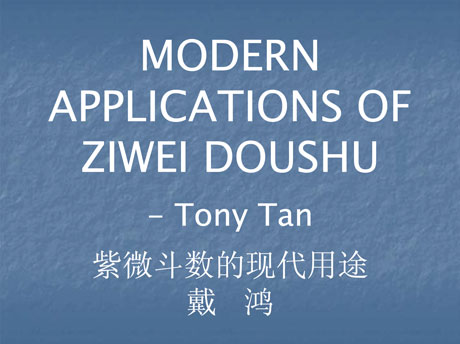
Commentary - Ziwei Doushu first appeared in the Song Dynasty, hence, it has a history of slightly more than 1,000 years.
Slide 2
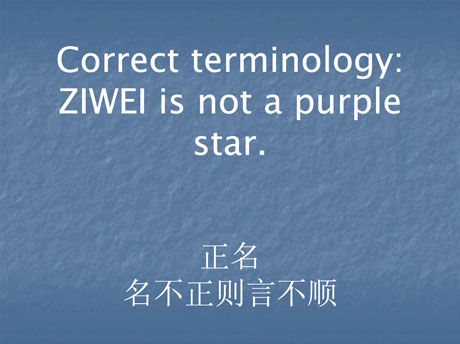
Commentary - There is nothing *purple* in Ziwei Doushu. It is wrong to call Ziwei the purple star, thus, it is wrong to call Ziwei Doushu the Purple Star Astrology. For instance, there is nothing purple in Zijincheng - the Forbidden City (the Purple City?), and there is nothing purple in Ziqi Donglai - auspiciousness (purple energy from the East?). It is like we cannot translate white elephant from English to Chinese directly - there is nothing white, and it is not even an elephant.
Slide 3 & 4
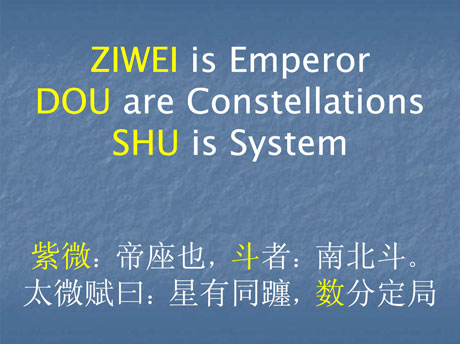
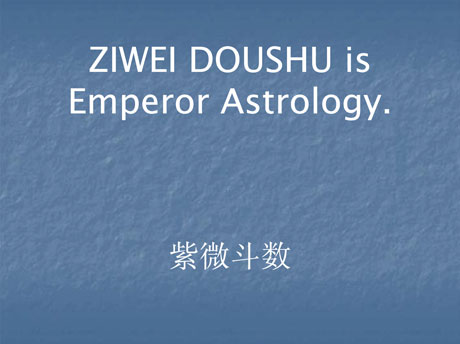
Commentary - Ziwei refers to the centre of focus, the reference, the authority, etc., thus it is apt to translate it as the Emperor. Dou refers to the stars (symbols) when they are static, i.e., their essential quality. Shu refers to the systems the stars form when they move, and there are 120 systems. Shu therefore refers to the dynamism the stars create. However, it is critical to note that there are no real stars in Ziwei Doushu. The term *stars* is the accepted way to mean the *symbols* we use in Ziwei Doushu. Thus, Ziwei Doushu is Emperor Astrology.
Slide 5 & 6
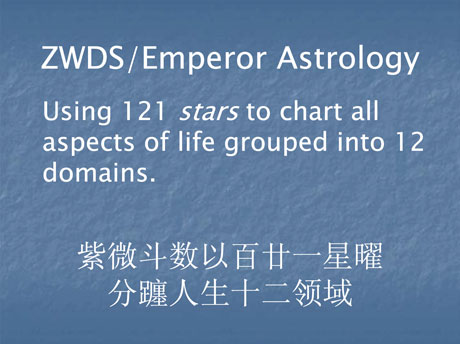
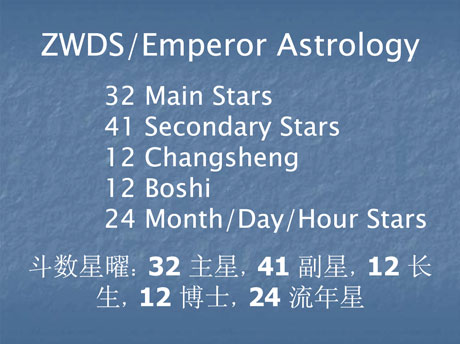
Commentary - There are a total of 121 *stars* used in ZWDS, but this figure depends on how we count them. For instance, the 12 Boshi Stars are employed twice, some may count them as 24 stars, etc.
Slide 7
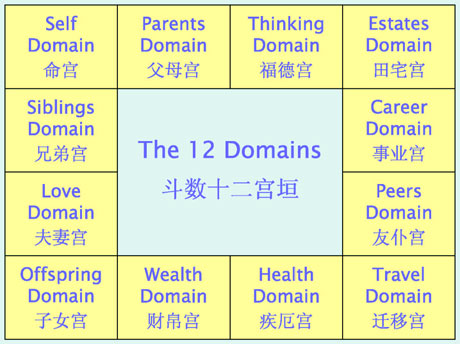
Commentary - These are the twelve domains of life that ZWDS interprets. I have chosen the word DOMAIN in place of PALACE or COURT because unlike face reading and Fengshui, the Chinese word gong here does not refer to a location or position. The Self Domain may be placed in any of the twelve frames, but the sequence of the twelve does not change. ZWDS is about reading the meaning of the stars when they are placed in the twelve domains.
Slide 8
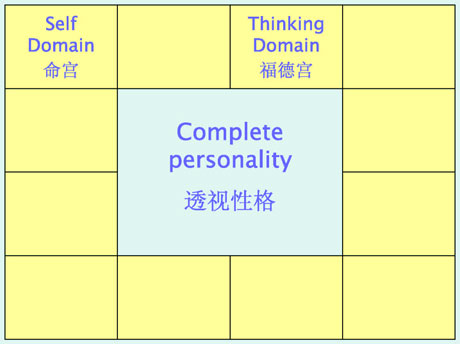
Commentary - These are the two domains we should interpret together to understand a personality completely. Thinking Domain is the most misunderstood of all the twelve because of the original Chinese words Fudegong, when fu generally means blessing and de generally means virtue or karma, but they do not mean those when it comes to Fudegong. We should call a spade a spade. Self Domain shows the outwardly apparent personality and the Thinking Domain reveals that part that is hidden.
Slide 9
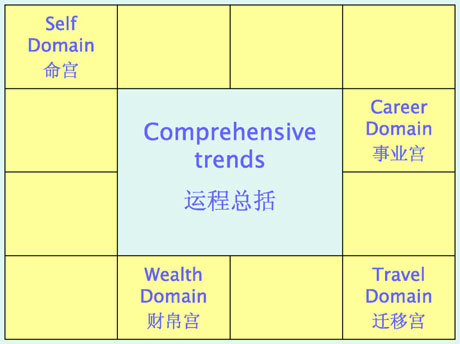
Commentary - These four domains form Sanfang Sizheng - what I call the Matrix. They reveal the aggregate strength (luck) of destiny we have in this life.
Slide 10
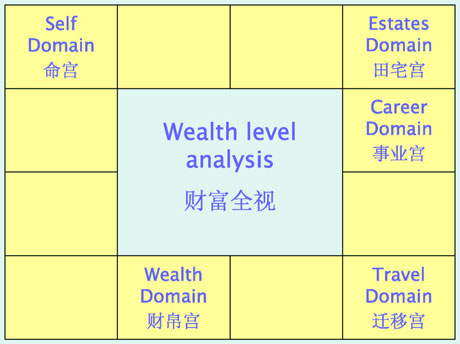
Commentary - To assess how wealthy one can be, we have to also include the interpretation of Estates Domain as it represents wealth beyond liquid cash.
Slide 11/12/13
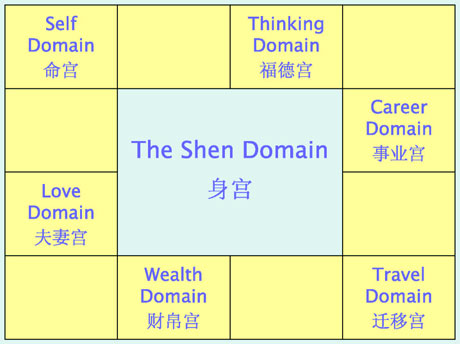
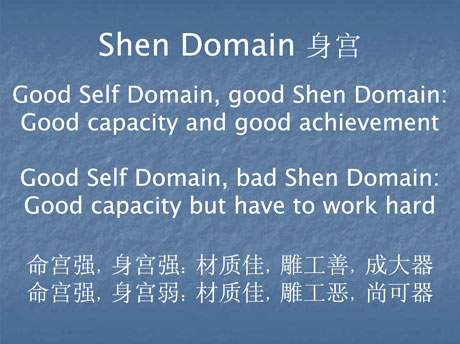
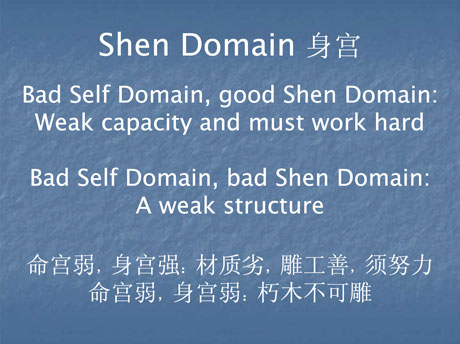
Commentary - Beyond the twelve domains, there is a Shengong - what I call a supplementary domain, or the domain of main influence, but it is formed by one of the six domains shown in Slide 11.
Slide 14
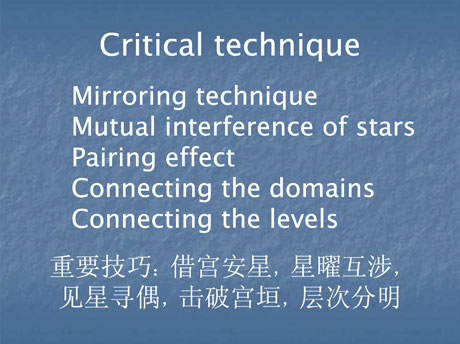
Commentary - This shows the key interpretation technique of ZWDS. One will never understand the true power of ZWDS if one does not get familiarised with their applications.
Slide 15
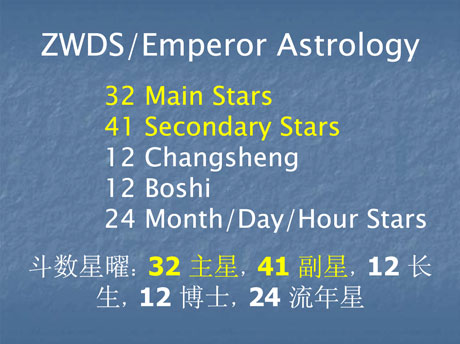
Commentary - First, the Mirroring Technique. It is used when a domain is found to be void of the 14 Major Stars (from the Emperor Ziwei to the Forward General Pojun). Regardless of how many other stars are present in a domain, when a domain is void of any of the 14 Major Stars, we have to use the stars present in the opposite domain. All the stars in the two groups of 73 stars (32 plus 41, in yellow fonts in the slide) found in the opposite domain must be mirrored into the domain to be interpreted. Merely mirroring the first 14 Major Stars, as it is widely taught, is wrong.
Slide 16
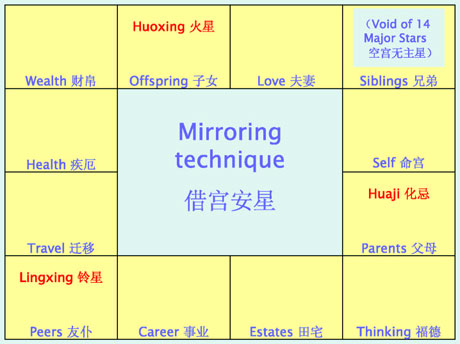
Commentary - The next three slides illustrate the Mirroring Technique. The Siblings Domain in the chart is void of Major Stars. The pair of Trouble Stars - Turmoil Star Huoxing and Turbulence Star Lingxing, are found to be placed in the Offspring Domain and Peers Domain respectively. They are not the 14 Major Stars, but part of the 32 Main Stars. They are the Adverse Stars that are the most menacing to human relationships.
Slide 17
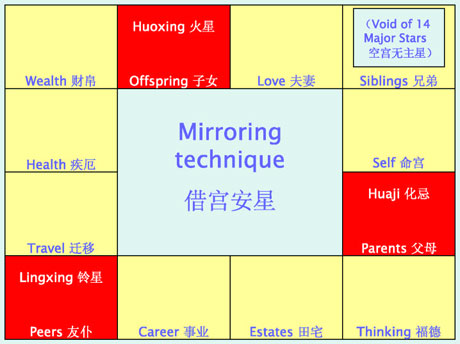
Commentary - In this chart, on the surface, three human relationship domains are negatively affected (in red) but not all five domains, if we do not mirror Turbulence Star Lingxing into the Siblings Domain which is void of the Major Stars. It therefore means that the Siblings Domain and Love Domain are not affect by the pair of Trouble Stars. This is the wrong interpretation result.
Slide 18
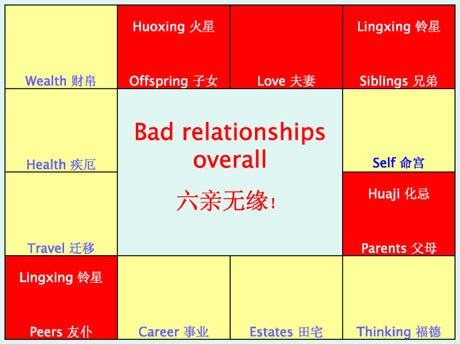
Commentary - When we mirror Turbulence Star into the Siblings Domain according to the correct application of the Mirroring Technique, we will have the correct interpretation result that all human relationship domains in this chart are ruined by the stars. The two that suffer the most impacts are the Parents Domain and Love Domain, the latter because of the flanking effect.
Slide 19
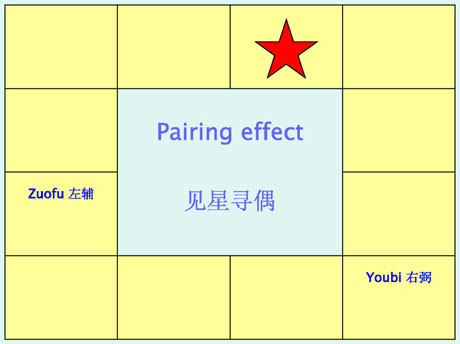
Commentary - Next, look out for the locations of stars that come in pairs. When a pair of stars are found in the Matrix, they give synergy. In this illustration, the Left Deputy Zuofu and the Right Deputy Youbi each affects the domains where they are placed, but the domain represent by the star symbol gets the most benefits.
Slide 20
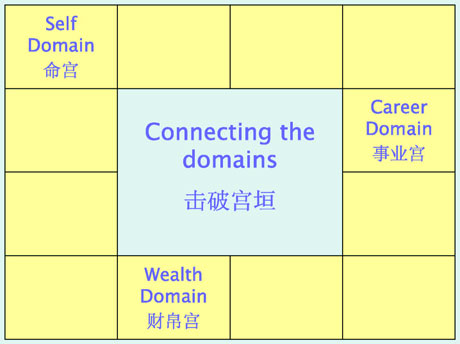
Commentary - This means that the interpretation of a ZWDS chart must not be done on individual domains only. In this illustration, Career Domain directly shows what industry or what sector is good for the subject, whether it is appropriate for him/her to take up a business or stay employed. However, his/her luck with money (Wealth Domain) also has a major influence on the job/business he takes on, while his/her personality (Self Domain) also plays a vital part in his/her rate of success in certain fields of job/business.
Slide 21/22/23


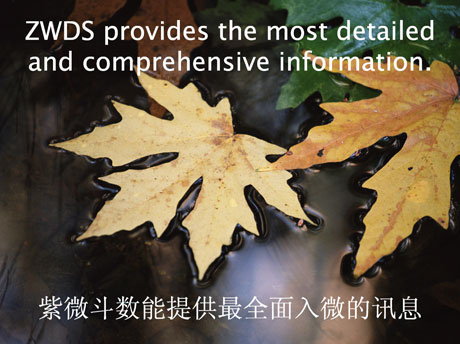
Commentary - With the availability of the enormous information ZWDS can provide, it is easy to fall into traps of such thought that we are unable to change our life or dictate our future - because so much have been written. Rather, the idea should be the other way round that we can make full use of the information to maximise our potential and to minimise risks and avoid pitfalls in life. The future is in our own hands. The next phase of slides illustrate this philosophy well.
Slide 24

Commentary - This is familiar to all of us, is it not? Their weightage of influence on our lives is the heaviest from the top down, while the amount of control we can exert over them is the biggest from the bottom up. To me, it is more critical to find out our likely trends first than to talk about Fengshui. For instance, when both the structural trends and the cycle luck of Estates Domain is good, it is easier for us to get a good house and good Fengshui. When they are the reverse, it is easier for us to get a bad settlement and bad Fengshui. Modern applications of ZWDS:
Slide 25/26
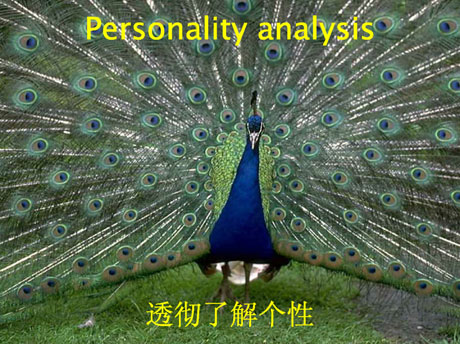

Commentary - Personality analysis. This is a chart of a young engineer. Passion Star Lianzhen and Pleasure Star Tanlang are about Peach Blossom luck and represent talent. When they are found to be in a combination like this, however, it indicates a free soul who prefers to wander than to get tied down, to express freely than to be meticulous, to be creative than to follow rules. Together with the pair of Interference Stars, Dikong and Dijie flanking the Self Domain, this quality is even more exaggerated. Do they fit the description of an engineer? The young man is already very frustrated with his daily work two years into the profession. This is a result of wrong guidance from the parents who wanted their children to have their (parents) choices of professions. What should he do now, especially in a society that is very restrictive? I have found out what his true talents are, and have encouraged him to indulge in those artistic talents over the weekends. This aims to balance his life.
Slide 27

Commentary - Personality analysis. This is the chart of the younger sister of the engineer, who is about to make a choice of study course. The mother wanted her to be a teacher, but she has wished to be in hospitality trades. In fact, the girl offered to pay me extra to dissuade her mother. I have told her there was no such necessity, as the combinations of her chart show that she would excel in tourism studies/work.
Slide 28/29

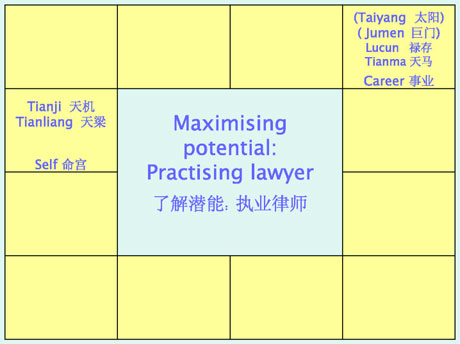
Commentary - Potential maximisation. When ZWDS is the most powerful in providing details about personality, it naturally helps to identify the best type of profession/business. Chief Advisor Tianji and Inspector Tianliang combines shows a clear and meticulous mind sharp in picking up details instantaneously. Combining with the stars found in the Career Domain, it is only appropriate that the subject is in the legal profession.
Slide 30

Commentary - Potential maximisation. This chart shows that the subject is born with the natural capacity of a business person. In fact, she was a homemaker because the husband was doing well, and she did not need to work. After the children have grown up, she started some business in a very small way but it grew naturally. In about ten years, she has four branches.
Slide 31/32


Commentary - Risk identification. With the power to go for details, ZWDS is certainly helpful for this function. Slide 32 shows a typical structure that the subject will be ultimately betrayed by the partner, while the initial period (a year, two years, etc.) does provide good returns.
Slide 33

Commentary - This is the same chart as in Slide 29. While the lawyer can excel in his profession well, he is to avoid investments, reading from his Wealth Domain.
Slide 34/35/36



Commentary - As ZWDS also provides details in periodic luck, it is an excellent instrument to help us in deciding the right timing. Slide 36 is the chart of young entrepreneur whose turnover met the qualification of the Young Entrepreneur Award if he were to submit his application. As he was sort of working for his family business, he wished to strike out totally on his own when he was 29. Going with the periodic luck, the Seal Minister Tianxiang indicates the luck of a number two instead of the luck of a leader. The advice was to put the idea off until his next decade. Meanwhile I have advised him to make use of the remaining years in the current period to learn all he can.
Slide 37

Commentary - This is from a chart that is structurally good, but the subject has made an investment in real estates during the period. Although that is the only one major mistake, it has also cause some great anxiety.
Slide 38

Commentary- Life Crisis Management. Likewise, prior information is the key here. We can work out the best solutions to a problem, and also find out the duration of a crisis.
Slide 39

Commentary- Compatibility Studies. Due to exactly its power to read personality and luck cycles, ZWDS is useful for studying the compatibility of business partners and marriage partners.
Slide 40

Commentary- Marital Counselling. ZWDS is an effective tool to carry out what I call alternative counselling, because it presents two people stripped nakedly in terms of personality. From there, their expectations in life and their expectations of a relationship can be described clearly. When they hear these from a third party, they are more willing to pay attention clearly. With the additional descriptions of what are the possible problems in the future, and in specific time frames, the prior information helps two people work better for the relationship. It is like they have found out what might be in store, and I have always encouraged them to take it as a task to overcome an issue or a bad patch in the future hand in hand. With the right intention and in the right frame of mind, we can alter course, or minimise the negative impact of a potential problem.
Slide 41

Commentary- HR Management. Enough is said by now about how to make use of ZWDS.
Slide 42/43


Commentary- Self explanatory.
Slide 44

Commentary- The 32 Main Stars have different degrees of brightness when they are placed in different positions. A bright star is able to show more of its strength while its weaknesses is minimised. A dim star manifests more of its weaknesses while its strength is reduced. There are altogether six or seven levels of brightness (left box), but I advocate simplifying them to a total of three (right box). There is no real requirement to go for such detailed grading, and we can afford to make learning ZWDS slightly easier.
Slide 45

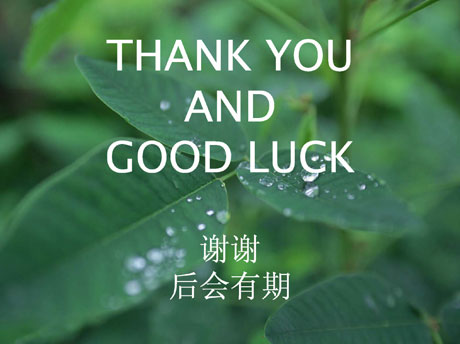
Commentary- Self explanatory.
(Article kind courtesy of Master Tony Tan, Harmony Academy of Chinese Metaphysics)
http://www.absolutelyfengshui.com/library/brief-history-of-zi-wei-dou-shu-1.php
















